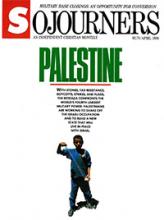The Road from Bethlehem to Hebron winds through rocky mountains and terraced hillsides, over vast plateaus that stretch down to the Dead Sea. Under a huge, cloudless sky bleached almost white by intense sunlight, this simple back road bends to accommodate land, people, animals, and crops. Curving past ancient stone walls and hardy olive trees, it passes below sheep and goats that graze on barren hillsides, through military checkpoints staffed by Israeli soldiers.
The trip is only 20 miles long, but the journey takes a traveler through thousands of years of history. It is this land that God promised to the descendants of Abraham and Sarah. It is here that Jesus was born. And it is this desolate, yet beautiful, place that the children of Isaac and Ishmael struggle to make their home. Up ahead there is a fork in the road.
Meanwhile, there is much to see: Bedouin shepherds grazing their livestock near the ruins of Herod's Palace; simple, generations-old Palestinian dwellings being destroyed to make way for high-rise Israeli condominiums; and donkeys loaded with kindling for Palestinians who now live in tents, ambling along the roadside, almost stumbling over the narrow pipe that carries water across miles of dry, barren land to the Israeli settlement that sits on the next hill.
A few miles outside Hebron, the road passes through the small Palestinian village of Sa'ir. Because of its isolation, steep hillsides, and its activist population, Sa'ir has become a stronghold of the Palestinian intifada, or uprising.
On this day huge boulders span the road, blocking the entrance to Sa'ir. It is unclear whether the Israeli army has placed the boulders there to keep the villagers in, or whether the villagers have blocked the road to keep the army out. As determined travelers spend more than 30 minutes clearing the road, village children perched high on a steep hillside watch closely.
Read the Full Article

